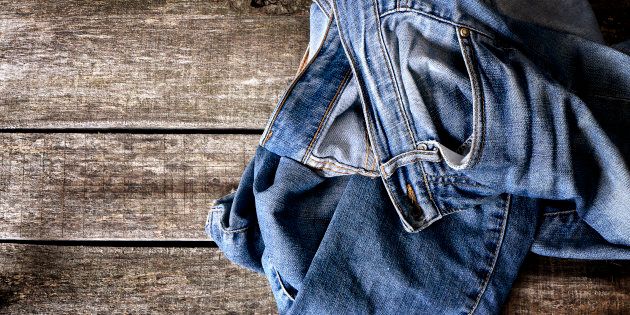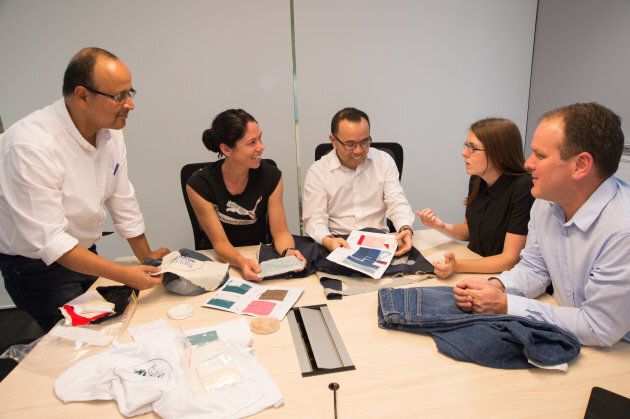
Consider your favourite pair of jeans for a second. Look down (you're probably wearing them).
Have you thought about what is behind that worn, comfy exterior?
Denim is one of the most widely used textiles, with approximately 1.2 billion pairs of jeans sold each year. But with an average pair using up to 200 litres of water in the dyeing process alone, this global obsession is straining the planet.
I've seen for myself rivers running in blue, indigo blue water, dead fish and all of that. It sticks in your mind .... it's natural that we need to do something about it.Xungai Wang, Deakin University
And it is one that Australian scientists are a step closer to changing.
A team of five from Deakin University in Victoria has developed technology that uses old jeans to colour new denim with zero water usage -- a project that saw them named one of five winners of the H&M Foundation's Global Change Award on Wednesday.

"We are tackling the biggest challenge facing the global denim industry....We think this is going to be a game changer," spokesperson Professor Xungai Wang told The Huffington Post Australia.
"I have visited countless denim manufacturing operations and have seen first hand the environmental problems associated with it. I have seen rivers running in blue, indigo blue water, dead fish and all of that. It sticks in your mind ... It's natural that we need to do something about it, and we have a unique approach to do that."
Harnessing innovation in fashion
The Global Change Award was launched by the H&M Foundation, the not-for-profit arm of the H&M Group retailer, in 2015.
From using old jeans to dye new denim to making fabric out of cow manure and vegetable leather out of wine by-products, the annual initiative searches for disruptive ideas that are set to reinvent and circulate the fashion industry.
In its second year, more than 2,300 applications were received from 130 countries and weighed up by a panel of international experts, with a one million Euro grant and a one-year 'Accelerator Program' offered to the winners.
These are problems that we have to solve -- we don't have a choice. The large companies aren't good at solving something that is going to disrupt what they are working on, so we are forced to take other approaches.
David Roberts
For Johan Kuylenstierna, panel member and Executive Director of the Stockholm Institute, innovation lies at the heart of sustainable development in any sector, particularly fashion.
"One thing that we can all be clear about is that competition over resources -- raw materials, water, land -- will be a central issue in the future. The fashion industry, with its basis in raw materials, is going to be fundamental to this," Juylenstierna told Huffpost Australia.
"This is essentially a matter of survival. We're not looking for short term fixes."
Among criteria including economic viability and scalability, panel member David Roberts said the winners were ultimately chosen based on their potential for future global impact.
"With disruption, these products or ideas always start worse off than the existing product. That's how it works. Over time, the disruptive thing gets good enough and has features that the existing thing doesn't -- and that's usually when you see this shift," Roberts told Huffpost Australia.
"When you look at these technologies, the thing to say is, what does this look like ten years from now? ... How quickly can we move towards the future that we all know has to be true?"

Having impact
For Professor Wang and his team, global impact means cuts to water, energy and waste consumption tied to traditional denim manufacturing and an efficient solution to recycling.
Their technology breaks down old pairs of jeans into a fine particle that can then be used to colour new, undyed denim, and make prints on to other textiles.
With one used pair of jeans, we can colour ten new ones and save up to 2,000 litres of water. Xungai Wang
"It mimics the traditional denim look without the adverse impacts associated with the traditional denim process. With just one used pair of jeans, we can colour ten new ones and save up to 2,000 litres of water," Wang said.

The team will use its 150,000 Euro grant to develop their equipment facilities and look to turn their prototype into denim garments within one year.
They hope to upscale production through industry partnering, anticipating 'denim-dyed denim' products will be commercially available within five years.
According to Wang, the approach will reduce production costs.
"When it comes to energy consumption, half of the denim manufacturing process is in the colouration. We have removed this. Discharge waste costs are also great (you can't discharge coloured water into waterways), so by using this technology, there are huge cuts to water, waste and energy use," Wang said.
And this is good news for the future customer.
"No matter how good a product is, customers won't pay twice the price for a pair of jeans, so we had to make sure this was economically viable," he said.
"The look and feel will be slightly different and there may be some novelty in that, which could be good for consumers."
Emma Brancatisano travelled to Sweden to attend the Global Change Awards as a guest of H&M Australia.
ALSO ON HUFFPOST AUSTRALIA